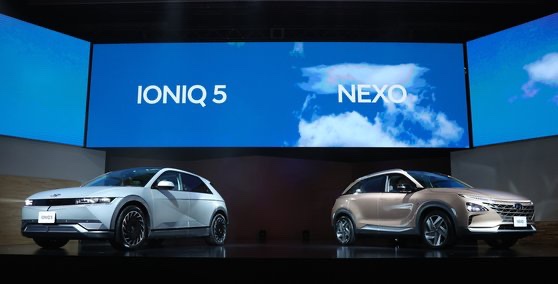
Korean EVs: Not eligible for US subsidies!
-Inflation Reduction Law Enacted-
Tax deduction for “only vehicles assembled in North America”
Joe Biden:
US president
Inflation Reduction Act signed on 16th (local time)
Only for electric vehicles with certain requirements,
Used cars up to $4000,
New cars up to $7,500,
Includes tax deductions.
but,
The only types of vehicles that benefit from the tax credit are “vehicles assembled in North America.”
From next January,
“Batteries produced in the United States and other countries with a certain ratio or more”
There are “additional conditions such as the use of core minerals.”
EVs made in Korea:
Currently, five models are sold in the United States.
the IONIQ 5,
the Kona EV,
the Genesis GV60,
the EV6,
the Niro EV.
However, “Because it is produced in South Korea, its price competitiveness will decline.”
Joongang Ilbo |
https://s.japanese.joins.com/JArticle/294525?sectcode=210&servcode=200
Véhicules électriques coréens : non éligibles aux subventions américaines !
-Promulgation de la loi sur la réduction de l’inflation-
Déduction fiscale pour “uniquement les véhicules assemblés en Amérique du Nord”
Joe Biden:
Le président américain
La loi sur la réduction de l’inflation signée le 16 (heure locale)
Uniquement pour les véhicules électriques avec certaines exigences,
Voitures d’occasion jusqu’à 4000$,
Voitures neuves jusqu’à 7 500 $,
Comprend les déductions fiscales.
mais,
Les seuls types de véhicules qui bénéficient du crédit d’impôt sont les « véhicules assemblés en Amérique du Nord ».
Dès janvier prochain,
“Piles produites aux États-Unis et dans d’autres pays avec un certain rapport ou plus”
Il y a “des conditions supplémentaires telles que l’utilisation de minéraux de base”.
Véhicules électriques fabriqués en Corée :
Actuellement, cinq modèles sont vendus aux États-Unis.
la IONIQ 5,
le Kona électrique,
le Genesis GV60,
l’EV6,
le Niro EV.
Cependant, “Parce qu’il est produit en Corée du Sud, sa compétitivité des prix va baisser.”
Joongang Ilbo |
Koreanische Elektrofahrzeuge: Nicht für US-Subventionen geeignet!
-Inflationsminderungsgesetz erlassen-
Steuerabzug für „nur in Nordamerika montierte Fahrzeuge“
Joe Biden:
Amerikanischer Präsident
Inflationsminderungsgesetz unterzeichnet am 16. (Ortszeit)
Nur für Elektrofahrzeuge mit bestimmten Anforderungen,
Gebrauchtwagen bis 4000 $,
Neuwagen bis 7.500 $,
Beinhaltet Steuerabzüge.
aber,
Die einzigen Fahrzeugtypen, die von der Steuergutschrift profitieren, sind „in Nordamerika zusammengebaute Fahrzeuge“.
Ab nächsten Januar
„Batterien, die in den Vereinigten Staaten und anderen Ländern mit einem bestimmten Verhältnis oder mehr hergestellt wurden“
Es gebe “zusätzliche Bedingungen wie die Verwendung von Kernmineralien”.
In Korea hergestellte Elektrofahrzeuge:
Derzeit werden fünf Modelle in den Vereinigten Staaten verkauft.
der IONIQ 5,
der Kona EV,
der Genesis GV60,
der EV6,
der Niro EV.
Allerdings: “Weil es in Südkorea produziert wird, wird seine preisliche Wettbewerbsfähigkeit sinken.”
Joongang Ilbo |
Korean-made EVs Not Eligible for U.S. Subsidies –
Starting from Aug. 16 (local time),
the United States
halted paying subsidies for electric vehicles (EVs) not assembled in North America.
U.S. President Joe Biden signed
the Inflation Reduction Act on the day. The U.S. government released a list of EVs eligible for subsidies.
Only 21 models
assembled in North America will be subsidized up to US$7,500 per unit by the end of the year.
The list does not include
Hyundai Motor Group’s five models sold in the U.S. market —
the IONIQ 5,
the Kona EV,
the Genesis GV60,
the EV6,
the Niro EV.
the U.S. government
selected subsidized EVs this time based on final assembly conditions in North America,
it added that it would announce a new list in January next year.
It will also demand a certain North American manufacturing ratio
with respect to parts and minerals for batteries used in EVs in 2023.
This policy has put Korean producers of automobiles and batteries on red alert.
Among overseas automakers,
the subsidies will be given to some EV and PHEV models from Mercedes-Benz, Audi, BMW, Jeep, and Volvo which were produced in North America.
Only one EV model of Nissan made the list among Asian companies.
Although Tesla and GM have met North American manufacturing standards,
they are subject to a subsidy limit of up to 200,000 units per brand, so their cars will be able to receive subsidies beginning from 2023.
In the first half of this year,
Hyundai Motor Group came in second in EV sales standings in the United States with a market share of about 9 percent after Tesla with 70 percent.
Although Tesla was overwhelming, major Hyundai models such as the IONIQ 5 and the EV6 were well-received, beating out its competitors such as Ford and Volkswagen.
the group has exported about 40,000 EVs to the United States until July.
The three major Korean battery makers — LG Energy Solution, SK On, and Samsung SDI —
are also highly likely to suffer a setback under the new subsidy rule.
This is because regulations on battery manufacturing regions and raw material procurement will come into effect.
The use of Chinese battery components and Chinese battery minerals
will be completely banned from 2024 and 2025, respectively.
Businesskorea
http://www.businesskorea.co.kr/news/articleView.html?idxno=98696